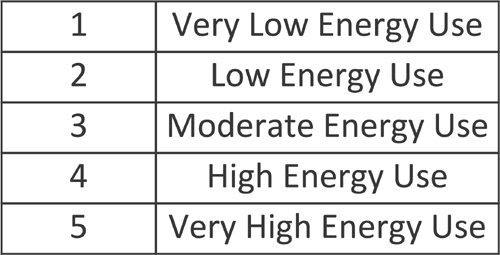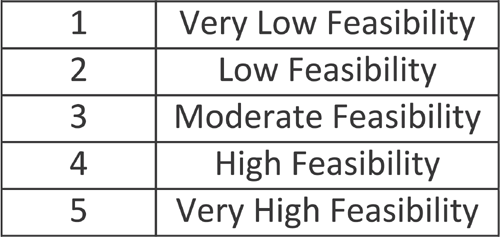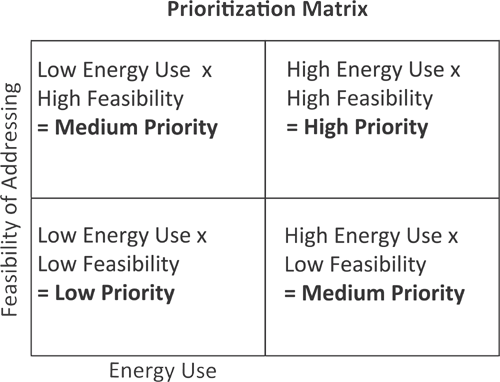5.6 Criticality Related to Energy Use
Another component to consider when assessing which assets are critical to the process is energy use. If the asset is a high energy user, there is an operational cost associated with that energy use. Ranking assets according to energy use in a manner similar to the condition and consequence rankings will allow energy to be a consideration in the overall process of criticality.
There are many factors to consider when assessing criticality related to energy efficiency. Most of these factors fall within two major headings: the asset's impact on energy use, and the feasibility of addressing the energy use of the asset through installing a new asset or some other method. Discussed below are criteria that can be considered.
When an asset uses energy - either directly or indirectly - its impact on energy use and energy efficiency goals should be considered. The following criteria describe some of these considerations.
- Meets Energy Efficiency Goals:
When determining criticality for energy purposes, it is important to discuss whether the asset currently contributes to meeting the utility's energy goals or whether it is a factor in not meeting the goals. If the asset is allowing the utility to meet its energy goals, it should be given a low score (i.e., low criticality) and if it is not meeting the energy efficiency goals it should be given a high criticality score. - Energy Use:
If an asset uses large amounts of energy, there may be a potential for significant energy use reductions related to installing a more energy efficient asset. If the asset uses very little energy or the asset is already as energy efficient as practical, there may be little potential for reducing the energy use. Assets that have a high energy usage should be given a higher rating than assets that have a low energy use. This evaluation should use actual energy use data when available. - Renewable Source of Energy:
When considering energy use, understanding how the energy source impacts the environment may be an important part of the energy criticality evaluation. If an asset is a significant contributor to greenhouse gas emissions it may be given a higher rating. If an asset uses a renewable energy source, it would be given a lower ranking.
A table showing a 1 to 5 ranking system is presented below.

The second aspect of the criticality discussion for assets that use energy is the feasibility of addressing the energy use. For the utility to be able to address the energy use of an asset, there must be a feasible alternative to the current asset, or a more efficient way to operate it, or a different energy source. The more feasible the project is, the higher the ranking should be. The less feasible, the lower the ranking. - Potential Alternatives:
When deciding if the asset's energy usage can be reduced, consideration must be given to whether there are potential alternatives to the current asset. For example, an asset may be 65% efficient and the utility may desire it to be 75% efficient, but this increase is not possible if there is not a replacement asset on the market with that efficiency rating. Consideration must also be given to operational changes that may be required by the alternative. The more feasible a potential alternative is, the higher the criticality ranking score. - Costs:
There may be alternatives to the asset as described above, but both capital and operational costs of the alternative(s) must be considered. Additionally, any cost savings that will result from the reduction in energy usage should be taken into consideration. The operational cost savings can be compared to the capital cost to determine how long it would take in savings to pay for the capital. The shorter the period, the better the project. The energy source of the original asset and any potential alternatives should be considered as well. When converting from one source of energy to another (i.e. electricity to natural gas) the operational costs may be significantly impacted. Any non-monetary costs - either positive or negative - should also be considered, such as social and environmental costs. The lower the costs or the greater the energy savings, the higher the criticality ranking. - Availability of Funding, Financing or Rebates:
The question must be asked, How can the potential energy reduction alternative be paid for? If funding is available or if there are specific rebates or other incentives in the funding for the alternative, the project criticality ranking is higher. - Operability:
Is it possible for the alternative to be operated with current staff upon completion? If the answer to this question is yes the ranking should be higher and if the answer is no, the ranking should be lower. - Regulatory Requirements:
If an alternative is required to meet new or existing state or federal regulations or to address non-compliance, it should be given a higher ranking.

Similar to the approach with probability of failure and consequence of failure the assets can be ranked according to energy usage and ability to address the energy usage. The assets can be given a score of 1 to 5 for energy usage and a score of 1 to 5 for the potential to address the energy usage. The assets with the highest scores would be those that have both high energy usage and high ability to do something about it. These assets would be "critical" from the standpoint that if the asset were replaced or rehabilitated in some way related to energy, the utility would benefit.
When the factors for energy use and feasibility have been considered, a matrix similar to the one in section 5.5 can be constructed.

The same ranking tables and graph from above can be used with energy projects.

